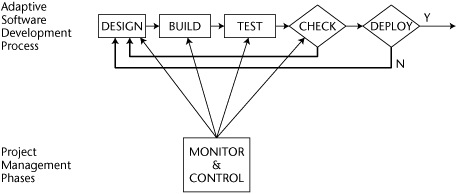The Monitoring and Controlling Phase of an Adaptive SDPM Strategy
Figure 28-1 highlights the Monitoring and Controlling Phase of an Adaptive SDPM strategy.
Figure 28-1. The Monitoring and Controlling Phase of an Adaptive SDPM strategy

First note the inclusion of the Check Phase as a very visible part of the Systems Development Life Cycle. It was part of the Iterative SDPM strategy, but here it takes on a different posture. Here the client is more proactively involved with the development team. The learning and discovery that was generated in the just completed iteration is now used to identify next steps. Those next steps include not only integrating new functions and features but also probing with new initiatives aimed at further learning and discovery. This proactive posture was not as prevalent in the Iterative SDPM strategy because the discovery of new or modified features was not as demanding as the discovery of new or modified functionality. Much more is asked of the development team and the client in an Adaptive SDPM strategy than in the Iterative SDPM strategy. In the most extreme of the adaptive cases very little will be known about the solution from the standpoint of functionality. It has to be discovered. But it isn’t going to be discovered just because you want it to be. It’s hard work and requires all of the creativity that the client and the development team can ...
Get Effective Software Project Management now with the O’Reilly learning platform.
O’Reilly members experience books, live events, courses curated by job role, and more from O’Reilly and nearly 200 top publishers.

